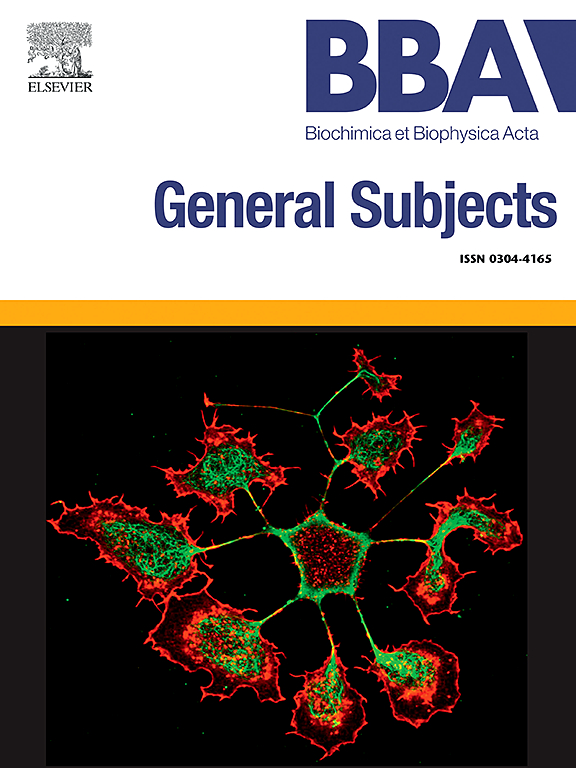A novel three-dimensional co-culture model for studying exosome-mediated cell interactions in glioblastoma
IF 2.8
3区 生物学
Q3 BIOCHEMISTRY & MOLECULAR BIOLOGY
Biochimica et biophysica acta. General subjects
Pub Date : 2025-01-08
DOI:10.1016/j.bbagen.2024.130752
引用次数: 0
Abstract
Three-dimensional(3D) cell culture systems provide a larger space for cell proliferation, which is crucial for simulating cellular behavior and drug responses in the tumor microenvironment. In this study, we developed a novel 3D co-culture system for cell interactions, utilizing a commercialized bioreactor-microcarrier system. Mesenchymal stem cells (MSCs) were extracted via enzymatic digestion, and markers CD105 and CD31 were identified. Cell growth was observed using AO and immunofluorescence staining. No significant differences in Ki67 and GFAP expression were found between 2D and 3D cultures, though the 3D system offered more space for proliferation and reduced contact inhibition. Therefore, this 3D culture system may represent the tumor microenvironment more accurately than 2D cultures and will facilitate the investigation of the characteristics and functions of exosomes derived from this system. Exosomes are nanoscale vesicles that mediate intercellular communication by transferring molecules such as miRNAs between cells. Exosomes from 3D cultures were collected via ultra-high-speed centrifugation and characterized using nano-flow cytometry, transmission electron microscopy, and western blotting for markers CD9, Alix, and TSG101. PKH26 staining revealed peak exosome uptake by tumor cells at 24 h and complete metabolism by 72 h. Exosomes from 3D cultures inhibited GBM cell proliferation, migration, and invasion. Lastly, miRNA sequencing of exosomes was performed. This study emphasizes the importance of creating 3D co-culture systems to advance cancer research and offers a helpful tool for studying the complex cell interaction environment of GBM and other malignancies.
研究胶质母细胞瘤中外泌体介导的细胞相互作用的新型三维共培养模型。
三维(3D)细胞培养系统为细胞增殖提供了更大的空间,这对于模拟肿瘤微环境中的细胞行为和药物反应至关重要。在这项研究中,我们开发了一种新的3D共培养系统,用于细胞相互作用,利用商业化的生物反应器-微载体系统。酶切法提取间充质干细胞(MSCs),鉴定标记物CD105和CD31。AO染色和免疫荧光染色观察细胞生长情况。在2D和3D培养中,Ki67和GFAP的表达没有显著差异,尽管3D系统为增殖提供了更多的空间,减少了接触抑制。因此,这种3D培养系统可能比2D培养更准确地代表肿瘤微环境,并将有助于研究该系统衍生的外泌体的特征和功能。外泌体是一种纳米级的囊泡,通过在细胞间转移分子(如mirna)来介导细胞间通讯。通过超高速离心收集3D培养的外泌体,并使用纳米流式细胞术、透射电镜和CD9、Alix和TSG101标记物的western blotting对其进行表征。PKH26染色显示肿瘤细胞在24 h时达到外泌体摄取的峰值,在72 h时完全代谢。3D培养的外泌体抑制GBM细胞增殖、迁移和侵袭。最后,对外泌体进行miRNA测序。本研究强调了创建三维共培养系统对推进癌症研究的重要性,并为研究GBM和其他恶性肿瘤复杂的细胞相互作用环境提供了有益的工具。
本文章由计算机程序翻译,如有差异,请以英文原文为准。
求助全文
约1分钟内获得全文
求助全文
来源期刊

Biochimica et biophysica acta. General subjects
生物-生化与分子生物学
CiteScore
6.40
自引率
0.00%
发文量
139
审稿时长
30 days
期刊介绍:
BBA General Subjects accepts for submission either original, hypothesis-driven studies or reviews covering subjects in biochemistry and biophysics that are considered to have general interest for a wide audience. Manuscripts with interdisciplinary approaches are especially encouraged.
文献相关原料
公司名称
产品信息
索莱宝
Triton-X 100
 求助内容:
求助内容: 应助结果提醒方式:
应助结果提醒方式:


